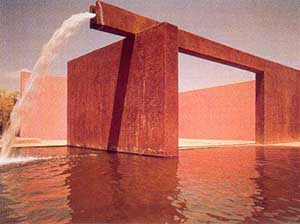Luis Barragán
La revolución callada
Luis Barragán (1902 — 1988) is considered the most important Mexican architect of the twentieth century and also one of the great figures in the field of architecture on the international scene. Barragán, who received the prestigious architectural award of the Pritzker prize in 1980, won attention and international recognition for the poetic quality of his work. His buildings and landscape designs, although not very numerous and concentrated in Mexico, display a talent that succeeded in marrying the traditional building methods of his country with the language of modernity, obtaining results that were at the same time Mexican and intrinsically universal. He was one of the first architects to use landscape in architecture, both in his country houses and in the private homes that he constructed in the district of El Pedregal. Light and colour, the search for a domestic quality that was at once modern and traditional, the relationship between architecture and landscape and between architecture and the city were the main themes on which this architect’s work was based. His trust in the power of simplicity, his tireless quest for material and aesthetic quality, his subtle sensitivity to colour, and finally his particular way of “seeing” leave their mark on all his work and make any attempt at imitation quite impossible. He was admired by the Minimal movement, for example by Donald Judd, and also by his colleagues, such as Louis Kahn, who invited Barragán to work with him. The exhibition covers Luis Barragán’s extensive architectural output through plans and drawings and a wealth of documentation; all complemented by the showing of five videos which present some of Barragán’s most spectacular designs in greater detail.



